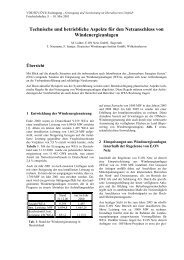controller parameters by using a decoupling filter
controller parameters by using a decoupling filter
controller parameters by using a decoupling filter
You also want an ePaper? Increase the reach of your titles
YUMPU automatically turns print PDFs into web optimized ePapers that Google loves.
Afterwards the control design process based on this<br />
mathematical model will be shown and the performance of<br />
the developed <strong>controller</strong> will be presented.<br />
2. Modelling of the HVDC system<br />
As already mentioned in the previous section, the first step<br />
is to analyse the HVDC system in order to obtain a simple<br />
mathematical model. At first the transmission equation can<br />
be directly obtained from Figure 1.<br />
d I<br />
IR+ L = U −U<br />
dt<br />
d<br />
d d d d1 d2<br />
The voltage drop along the DC line, between the rectifier<br />
and inverter, can be replaced <strong>by</strong> equation (2) and (3),<br />
which show the correlation between the DC voltages U d1<br />
and U d2 , the DC current I d , the firing angle α r , the<br />
extinction angle γ i and the corresponding phase to phase<br />
voltages of the AC grids U nr and U ni [3].<br />
(1)<br />
Ud1 = B 3 2 U 3<br />
nr<br />
cosα<br />
r<br />
− B XCrI d<br />
π<br />
π<br />
(2)<br />
Ud 2<br />
= B 3 2 U 3<br />
n i<br />
cosγ<br />
i<br />
− B XCiI d<br />
π<br />
π<br />
(3)<br />
Where X Cr and X Ci are the short-circuit reactances of the<br />
AC grids. As the extinction angle γ i is not an actuating<br />
variable of the system it can be replaced with its<br />
appropriate firing angle α i . For a six-pulse converter the<br />
constant B is fixed to one (B = 1). Inserting equations (2)<br />
and (3) in equation (1) yields equation (4).<br />
d Id<br />
IR<br />
d d<br />
+ Ld<br />
=<br />
d t<br />
3 2 3<br />
= ( U cosα<br />
+ U cosα<br />
) − ( X<br />
π<br />
π<br />
+ X ) I<br />
nr r n i i Cr Ci d<br />
This equation describes a nonlinear system and needs to be<br />
linearized. This can be done through use of the Taylor<br />
series decomposition method, where the differential terms<br />
with orders greater than one are neglected. After the<br />
linearization the equation can be transferred to the Laplace<br />
domain.<br />
(4)<br />
I<br />
d<br />
(s)<br />
2U<br />
sinα<br />
α (s)<br />
π π<br />
s Ld + Rd + XCr + XCi<br />
3 <br />
3<br />
nr 0 r<br />
= −<br />
r<br />
−<br />
G11<br />
2U<br />
ni<br />
sinα0i<br />
π<br />
d<br />
+<br />
d<br />
+<br />
Cr<br />
+<br />
Ci<br />
3<br />
−<br />
αi<br />
(s).<br />
π<br />
s L R X X<br />
3 <br />
G12<br />
The next step is to deduce the relation between the firing<br />
angles and the inverter side DC voltage U d2 . Therefore<br />
equation (3) will be linearized and transformed to the<br />
Laplace domain.<br />
(6)<br />
Ud 2<br />
(s) = 3 2 U 3<br />
n iαi (s)sin α0i − XCiI d<br />
(s) (7)<br />
π<br />
π<br />
Replacing the DC current I d in equation (7) with (6)<br />
yields equation (8).<br />
Ud2(s)<br />
=<br />
π π<br />
s Ld + Rd + X<br />
3 2<br />
Cr<br />
= U<br />
3 3<br />
ni<br />
sin α0i αi<br />
(s)<br />
π<br />
π π<br />
s Ld + Rd + XCr + XCi<br />
<br />
3 3<br />
G22<br />
3 2<br />
X<br />
Ci<br />
− U<br />
nr<br />
sin α0 r<br />
αr<br />
(s)<br />
π<br />
π π<br />
s Ld + Rd + XCr + XCi<br />
<br />
3 3<br />
G21<br />
Summarizing equation (6) and (8) yields in the transfer<br />
matrix G.<br />
⎛ Id (s) ⎞ ⎛G11 G12 ⎞⎛αr<br />
(s) ⎞<br />
⎜ ⎟=<br />
⎜ ⎟⎜ ⎟<br />
⎝Ud2(s)<br />
⎠ ⎝G21 G22 ⎠⎝αi<br />
(s)<br />
⎠<br />
As the transfer matrix shows, the model is a two-variable<br />
system where all the variables are influenced <strong>by</strong> each<br />
other. The structure of the system is shown in Figure 3.<br />
α r<br />
G11<br />
G<br />
Id<br />
(8)<br />
(9)<br />
3 2<br />
Id (s) Rd + s LI<br />
d d<br />
(s) = − ( Unrαr (s)sinα0 r<br />
+<br />
π<br />
3<br />
+ Un iαi (s)sin α0i ) − ( XCr + XCi ) Id<br />
(s)<br />
π<br />
α 0r and α 0i are the operating points of the firing angle of the<br />
rectifier and the inverter respectively. Hence the transfer<br />
function of the DC current can be obtained:<br />
(5)<br />
G12<br />
G21<br />
α i<br />
Ud2<br />
G22<br />
Figure 3: Structure of the simplified HVDC Model





